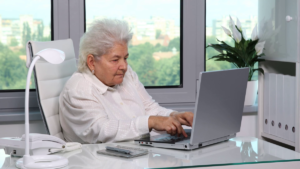
by Lauren Popham, PhD
We weren’t surprised when more than half of women responding to a survey we conducted with Ipsos said they are worried about outliving their savings. Income is tied to lots of aspects of aging, but the way that plays out once you turn 60 is very different for men and women. One major reason: the gender pay gap.
Women are more likely to experience financial insecurity than men, and this discrepancy becomes even more pronounced later in life. Making less than their male coworkers means women have less money saved when they retired, and will draw less money from Social Security once they’re eligible. We’re left with sobering statistics like this from the Health and Retirement Study: half of women age 60 or older have household incomes below $39,600, yet the median income for men in the same age range is $55,000.
Despite entering retirement age at a disadvantage, women tend to live longer and face more out-of-pocket costs for things like medication each year. This longevity means that women’s limited income and assets have to be stretched even further than men’s. Older adults of color fare even worse. Around one in five older Black/African American and American Indian/Alaskan Native women is in poverty, with an annual household income of just $12,490 for a one-person home.
So much of our work is focused on public benefits programs because they play a critical role in helping low-income older adults stay economically secure. Many eligible older adults miss out on these benefits because they are not aware of the programs or they do not know how to apply. Since 2010, the Center for Benefits Access at NCOA has helped over 368,000 older women through community-based organizations enroll in benefits to pay for basic expenses to meet their health needs.
Among these benefits are Medicaid, the Supplemental Nutrition Assistance Program (SNAP) to pay for food, Medicare Savings Programs to afford premiums, Part D Extra Help/Low Income Subsidy to afford prescription drug costs, and the Low Income Home Energy Assistance Program to pay heating and cooling bills. In addition, our online screening tool BenefitsCheckUp® (BCU) has connected an estimated 2.9 million women with benefits after they completed a screening. We know based on a recent evaluation that many eligible older adults who complete a screening on BCU go on to apply for and enroll in benefits.
Despite these concerns, the story of aging in America is hardly all doom and gloom. 61% of the seniors we surveyed are satisfied with their lives, and 59% expect to feel similarly in three years. That’s an important thing for everyone concerned about aging issues to remember. By working with today’s seniors and encouraging younger generations that the pay gap is an issue that affects us all, we can build a stronger movement to make aging well a reality for everyone.
